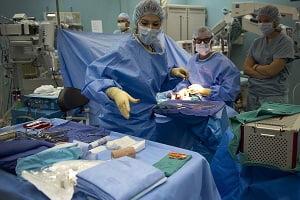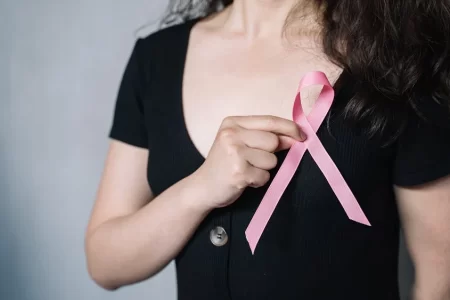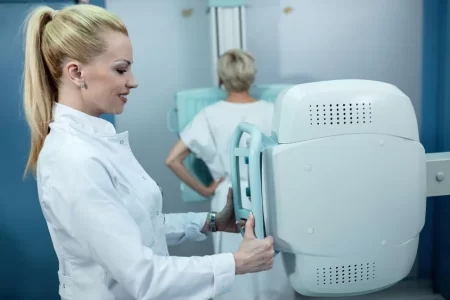Breast Cancer Surgery
- Updated on: Jul 29, 2024
- 6 min Read
- Published on Nov 18, 2020

Why You Need Breast Cancer Surgery?
Most women with breast cancer have to go under some surgery as a part of their treatment process. There are different types of breast cancer removal surgery, depending on the different reasons and situations. The type of breast cancer removal surgery you will have depends on:
- The size of the cancer
- The location of cancer in your breast
- Size of your breasts
- Your wishes and feelings
Breast cancer surgery can be performed to remove as much cancer as possible and find whether cancer has spread to the nearby lymph nodes under your armpits by using axillary lymph node dissection or to restore your breast shape after breast cancer removal surgery. Sometimes surgery can also be employed to relieve the symptoms of advanced breast cancer.
Based on your medical history and breast cancer features, your doctor will suggest you for specific breast cancer removal surgery, or you may be given a choice about which type of surgery to have. It is important for you to know about the various options of breast cancer surgery and choose in consultation with your doctor that is right for you.
Read About Hormone Therapy for Breast Cancer
What Are the Types Of Breast Cancer Surgery?
Two types of surgery are available for breast cancer:
- Breast-conserving surgery / partial mastectomy
- Mastectomy
Breast-Conserving Surgery/Partial Mastectomy
In a partial mastectomy, only cancer containing parts of the breast are removed. The main purpose of this surgery is to remove cancer and some surrounding normal tissue and leave behind as much healthy breast tissue as possible. Your doctor might also remove some or all of the lymph nodes in your armpit (axilla). This is also known as lumpectomy, quadrantectomy, or segmental mastectomy.
The size and location of the tumor and some other factors decide how much of the breast is removed during a partial mastectomy. You are most likely to have a radiation treatment to follow after partial mastectomy to prevent a recurrence. A breast lumpectomy is generally not advised if you are pregnant, have a large tumor, or cancer spread out of breast tissues.
You’ll have a scar on your breast, which is usually invisible when you wear a bra or swimming costume. You might have another scar under your armpit if your lymph nodes have also been taken away. These scars are not permanent and will fade a bit over time. Your surgeon will explain to you what to expect after a lumpectomy. He/she might be able to show you photos of what your breast is likely to look like afterward.
Advantages of Lumpectomy:
- It aims to keep most of the breast tissue intact.
- It causes less change to your body than mastectomy.
- It has a recovery time of a few weeks.
- Disadvantage of Lumpectomy:
- After the lumpectomy, your breast shape may get distorted.
- Radiotherapy to the breast is required for 3 to 5 weeks after a lumpectomy.
- The radiotherapy may induce its side effects and can make you tired for a few months.
- If the cancer recurrence occurs sometime later after lumpectomy, you won’t be able to have radiotherapy again and would need a mastectomy.
Read Mastectomy Procedure & Its Complications
Mastectomy
A mastectomy is the surgical removal of the entire breast, including all breast tissue and sometimes other nearby tissues. Your surgeon may recommend if the partial mastectomy or lumpectomy is not a viable option for you. This is usually employed for women who have cancer in multiple areas of the breasts or have large tumors relative to the breast’s size. When both breasts are removed during the surgery, it is known as a double mastectomy.
During a mastectomy, the surgeon removes the breast tissue (including the skin and nipple) and the tissues that cover the chest muscles. The muscle of the chest wall is rarely removed during the mastectomy and is known as radical mastectomy.
However, in many instances, a deliberate attempt is made after considering the various factors to spare much of the breast skin and even the nipple to improve the reconstruction outcome. There are different types of mastectomy, including:
- Nipple-sparing mastectomy in which there is the removal of the breast tissue only.
- Total (simple) mastectomy in which there is the removal of the breast tissue and skin.
- Skin-sparing mastectomy in which there is the removal of the breast tissue along with the nipple and areola.
- Modified radical mastectomy, where the lymph nodes under the arm are also removed along with the whole breast
There are various factors like the type of cancer and cancer location in the breast and/or lymph nodes, breast size, and breast shape that help determine which type of mastectomy should be performed. Your surgeon will explain every option and guide you through the decision-making process.
After the mastectomy, many women opt to have breast reconstruction surgery. During the reconstruction surgery, the surgeon creates a new breast shape for you. This surgery can be done simultaneously as breast cancer removal surgery (immediate reconstruction) or sometime later (delayed reconstruction).
Advantages of Mastectomy:
- It makes you feel more confident that your cancer won’t come back.
- It usually doesn’t involve radiotherapy after the surgery.
- You can have radiotherapy to the area as a treatment option if your cancer comes back in the future.
Disadvantages of Mastectomy:
- It involves the permanent removal of your breast.
- If you chose to have breast reconstruction, it could take some months to recover.
- If you don’t have breast reconstruction surgery, you might need to wear an external breast form (prosthesis).
What Are the Breast Cancer Surgery Side Effects?
Surgical procedures may leave short-term pain and tenderness in the treated area. Your skin in the breast area may feel tight, and the arm muscles may feel stiff or weak. Breast cancer removal surgery, which also involves removing lymph nodes, may sometimes cause swelling in the arm, a condition called lymphedema. Rarely, additional surgery may be required to remove cancer completely. There is also a risk of the treated area to get infected after surgery. In some cases, fluids get built up in your breast or armpit, causing swelling known as a seroma.
What to Expect After Breast Cancer Surgery?
You will recover well after breast cancer surgery with few major side effects, and it is true for most people.
You may wake up quickly from the anesthetic or may feel very sleepy for several hours afterward. After surgery, while you’re waking up, you may be wearing a nasal cannula or oxygen mask for an extra supply of oxygen. You may find a blood pressure cuff on your arm and a small device clipped to your finger so that your blood pressure, pulse, and oxygen level in your blood can be checked. Until you can drink, you will be given fluids through an intravenous drip.
Your wounds will get checked regularly by nursing staff. You will be advised to start by taking a few sips and gradually drink more, and when you can drink without any problem, you can then usually start eating. You will also be encouraged to get out of bed when you feel comfortable. You may feel weak or dizzy, possibly because of blood loss during surgery or your low blood pressure after the surgery. Your nursing staff will advise how far you should walk when you first get out of your bed.
Some people also have to deal with wound drain and problems with dressing and stitches just after surgery, either due to fluid build-up or some other stitch altering movements.
You will be given some exercises by a physiotherapist to regain arm and shoulder movement after surgery for breast cancer. You should ideally start doing these exercises the day after your surgery. However, if you had breast reconstruction surgery, the physiotherapist will talk to you about this as when and how to start doing exercises.
There are some possible complications listed below that may arise after breast cancer surgery. You should be aware of these and talk to your doctor if they happen during your stay at the hospital after your surgery.
- Pain and discomfort
- Nausea
- Bruising and swelling
- Seroma – fluid build-up around the wound
- Wound infection
- Hematoma – a collection of blood in tissues surrounding the wound
- Changes in sensation
- Scars
- Discoloration of breast skin after lymph node biopsy
- Stiff shoulder
- Cording – felling of tight cord under the skin which restricts the movement
- Lymphoedema – swelling of arm, hand, or breasts because of lymph fluid collection in surface tissue of the body.
What Is the Breast Cancer Surgery Recovery Time?
Recovery time after breast cancer surgery varies from patient to patient and depends on the type and extent of surgery you had and personal circumstances prevailing at that time. However, in general, a lumpectomy takes 7-14 days to fully recover after surgery, while a mastectomy may take 1-3 weeks as recovery time. Some people may need re-excision after a lumpectomy to ensure clear margins, which may take additional 3-7 days in recovery. Breast reconstruction surgery takes longer duration for full recovery owing to its complicated surgical procedure.











